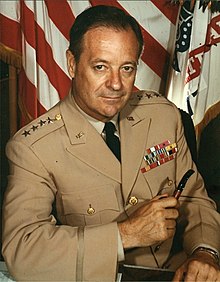Frank S. Besson Jr.
This article includes a list of general references, but it remains largely unverified because it lacks sufficient corresponding inline citations. (February 2008) |
Frank S. Besson Jr. | |
|---|---|
 General Frank S. Besson Jr. | |
| Born | May 30, 1910 Detroit, Michigan |
| Died | July 15, 1985 (aged 75) Walter Reed Army Medical Center |
| Allegiance | United States |
| Service/ | United States Army |
| Years of service | 1932–1970 |
| Rank | General |
| Commands held | United States Army Materiel Command Transportation Corps Military Railway Service |
| Battles/wars | World War II |
| Awards | Army Distinguished Service Medal (3) Legion of Merit (2) |
| Other work | Director, National Rail Passenger Corporation |
Frank Schaffer Besson Jr., CBE (May 30, 1910 – July 15, 1985) was a United States Army general.
Early life[]
Besson born on May 30, 1910 in Detroit, Michigan. His father was a West Point graduate and a colonel in the Corps of Engineers.
Military career[]
Besson graduated seventh in his class from the United States Military Academy in 1932. In 1935, he received a master's degree from the Massachusetts Institute of Technology. His early career was noted for the role he played in the development of portable military pipelines, steel landing mats for airplanes, and steel treadway bridges. He is credited with the studies leading to the army's adoption of the Bailey bridge, used extensively in all theaters in World War II.
Besson became Assistant Director of the Third Military Railway Service (with rank of lieutenant colonel) in 1943, and was promoted to Director (with rank of colonel) the following year. As Director of the Third Military Railway Service in Iran from 1944 to 1945, Besson ensured the flow of war materials to the Russian forces through the Persian Corridor. He was promoted to brigadier general, becoming, at 34, the youngest general officer in the Army Ground Forces and Chief of the Railway Division. Toward the end of World War II, he was Deputy Chief Transportation Officer of the Army Forces in the Western Pacific and, when Japan's collapse was imminent, assumed full control of railroads in Japan. During the first year of occupation, Besson directed the rehabilitation of the Japanese rail system, moving more than 200,000 troops and 150,000 tons of supplies in the first two months.
Subsequent assignments included a tour as Assistant Chief of Staff, Supreme Headquarters Allied Powers Europe (SHAPE), where Besson formulated logistics plans and overall programs to meet the complex requirements of the fifteen nations of the NATO alliance. His efforts in instituting a system for "costing out" five-year programs, thereby bringing force goals into consonance with available resources, earned him the first Army Distinguished Service Medal to be awarded at SHAPE headquarters.
Besson stimulated both military and commercial adoption of containerization and improved water terminal practices. He introduced the roll-on/roll-off technique for the rapid loading and discharge of wheeled and tracked vehicles. He further refined these concepts upon assuming command of the Transportation Center and School at Fort Eustis, Virginia in 1953. General Besson was the Chief of Transportation, United States Army from March 1958 until April 2, 1962, when he took charge of the United States Army Materiel Command.

Besson was the first Commander of the Army Materiel Command, formed in 1962 during a major army reorganization. During his command, the mammoth logistical organization, with an annual budget exceeding $14 billion and an inventory of $21 billion, employed more than 160,000 civilian personnel, in addition to its military complement of 14,000. As the first AMC Commander, Besson was charged with consolidating six army technical service organizations into a single command without disrupting effective materiel support for the army. His success resulted in his receiving the Merit Award of the Armed Forces Management Association in 1963. On May 27, 1964, 53-year-old Frank Besson became the 75th officer in the United States Army's 189-year history to wear the four stars of a full general. He was the first army officer to achieve that rank as head of a logistical organization in peacetime.
In March 1969, Besson left AMC to become chairman of the Joint Logistics Review Board, formed to review logistic activities in support of the Vietnam War. The board reported on logistical problems in Vietnam, including shortages of bombs and other weapons.
Besson, who left the review board in 1970, wrote about transportation and related problems in numerous professional journal. While in retirement, Besson was nominated by President Richard M. Nixon as one of the founding directors of the National Rail Passenger Corporation, which ran Amtrak. On July 15, 1985, Besson died of cancer at Walter Reed Army Medical Center.[1][2][3]
Besson's awards and decorations include the Army Distinguished Service Medal with two Oak Leaf Clusters, the Legion of Merit with one Oak Leaf Cluster, the Iranian , Honorary Commander of the Order of the British Empire, and the Republic of Korea's Order of Military Merit, Second Class (Ulchi).[4]
See also[]
References[]
 This article incorporates public domain material from the United States Government document: "404".
This article incorporates public domain material from the United States Government document: "404".
- ^ https://www.washingtonpost.com/archive/local/1985/07/18/retired-gen-frank-besson-dies/33c135bc-61be-478c-9456-3b9862ef1b71/
- ^ "Gen Frank Schaffer Besson Jr. (1910-1985) - Find A".
- ^ "Gen Frank Schaffer Besson Jr. (1910-1985) - Find A".
- ^ U.S. Army Transportation Corps Museum bio Archived March 14, 2008, at the Wayback Machine
- United States Army generals
- United States Military Academy alumni
- United States Army personnel of World War II
- Recipients of the Distinguished Service Medal (US Army)
- Recipients of the Legion of Merit
- Honorary Commanders of the Order of the British Empire
- Recipients of the Order of Military Merit (Korea)
- 1910 births
- 1985 deaths
- Military personnel from Detroit